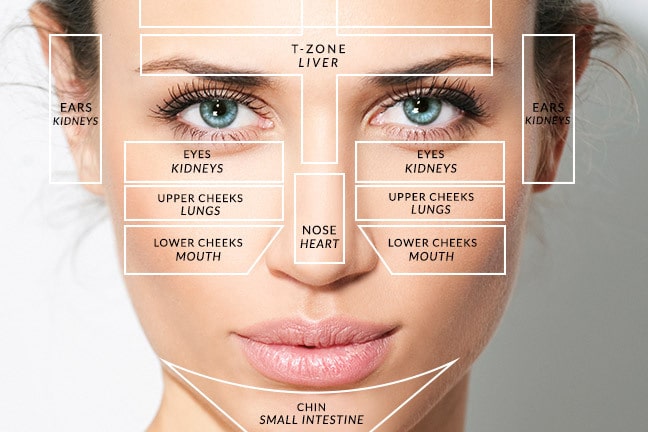There’s a myriad of products out there that are designed to banish skin breakouts. But eliminating acne is not always as easy as using a spot treatment or switching the contents of your skin care routine. Because sometimes, acne is caused by a deeper problem: something internal. And the acne will only clear up once that problem’s been cleared too. One of the best examples of this could be hormonal acne, though there are only a few internal health dilemmas that can present itself as blemishes.
According to alternative medicine practices, the places in your face where your acne shows up can provide you with great clues regarding the state of your internal heath. This practice is termed as face mapping—it examines the location of the skin diseases on the face in order to diagnose possible internal diseases. Face mapping is based on both Ayurveda and ancient Chinese medicines and its principles have begun to be included in some Western medical practices as explained by Michael Shapiro,MD, a
certified dermatologist and Founder and Director of Vanguard Dermatology.
Face mapping can be a great way to determine the possible things that may be ailing you, however, keep in mind that having a zit or two in any of these areas will not necessarily mean that you have
something very wrong going on inside your body. But if you have chronic acne that seems to never go away, it might be a good idea to ask your doctor to look into a potential link internally.
1. Forehead: This may point to poor digestion resulting from toxins and insufficient water intake. The greatest solution is to increase your water consumption in order to excrete these toxins off your system. Drink water through the day and stay clear of carbonated and caffeinated drinks as much as you can. However, cozying up with a mug of green tea might help your cause, since tea is loaded with antioxidants that can help remove toxins.
2. T-zone: Your nose is linked to your liver, so alcoholics, beware. People who have liver problems and have alcohol addiction sometimes develop a red nose because of this connection. Persistent acne in this area can sometimes signify liver dysfunction.
3. Around your eyes: The skin in this area is connected to your kidneys. Conditions like having dark eye circles may infer that you may be dehydrated or your kidneys are starting to malfunction.
4. Upper cheeks: The top of the cheeks may be connected to the lungs. Air pollution can severely contribute to this. As for the external factors, bacteria lodged on the surface of your mobile handsets or sleeping on dirty pillows can be huge culprits too.
5. Lower cheeks: This may signify poor dental hygiene or health. Problems involving the mouth especially gum diseases may show up here. Brushing the teeth regularly, flossing and veering away from sugary treats may improve your oral hygiene and the blemishes associated with it.
6. Nose: The nose is linked to the heart. Swelling of the nose or any bulbous changes in it may be indicative of elevated blood pressure. To correct this, modification in your diet is a must. Avoid the consumption of energy drinks, lessen your salt intake, and ensure to eat more fruits and vegetables for better health.
7. Ears: The ears are associated with kidneys too and
breakouts in this area may signal body dehydration. Again, reduction of your salt intake is needed to correct this and also to make sure that you drink ample amounts of water the entire day.
8. Chin: The chin is linked to your small intestine. Diet changes may be of help here. You should stay away from too much oil and dairy. Adopt a healthier diet by consuming more of vegetables and fruits to keep your digestive tract running smoothly, thus eliminating the possibility of having skin problems.
